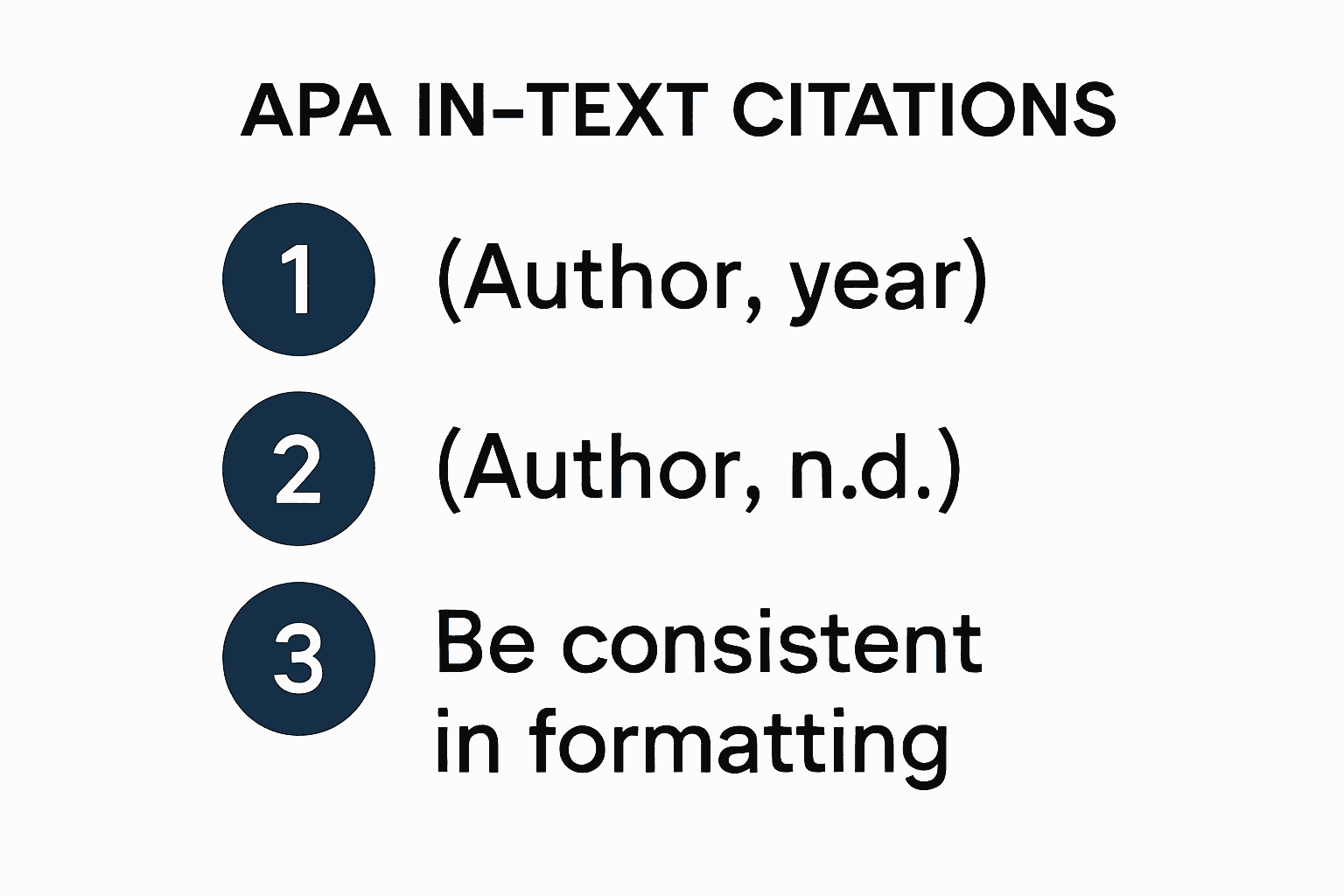Blog
Learning Materials
Guide 2025 pour les étudiants : Citation dans le texte APA sans année
Updated: July 7, 2025

Citer des sources dans un écrit académique peut rapidement devenir déroutant, surtout lorsque vous tombez sur un article ou un site web sans année de publication visible. Voici quelque chose de surprenant. Plus de 30 pour cent des sources numériques utilisées dans les essais universitaires manquent désormais dune année clairement indiquée. Vous pourriez penser que ce problème créerait le chaos, mais le style APA a un code simple qui transforme les dates manquantes en un non-problème et garde en fait votre recherche impeccable.
Table des Matières
- Comprendre les Règles de Citation APA dans le Texte Dockerfile README.md email-templates i18n-config.ts i18nConfig.ts next-sitemap-samwell.config.js next-sitemap-semihuman.config.js next.config.js node_modules package-lock.json package.json process_content.js public scripts src svgr.d.ts translations tsconfig.json Principes de Base des Citations APA dans le Texte Dockerfile README.md email-templates i18n-config.ts i18nConfig.ts next-sitemap-samwell.config.js next-sitemap-semihuman.config.js next.config.js node_modules package-lock.json package.json process_content.js public scripts src svgr.d.ts translations tsconfig.json Gérer les Sources Sans Années de Publication
- Comment Citer des Sources Sans Année Indiquée Dockerfile README.md email-templates i18n-config.ts i18nConfig.ts next-sitemap-samwell.config.js next-sitemap-semihuman.config.js next.config.js node_modules package-lock.json package.json process_content.js public scripts src svgr.d.ts translations tsconfig.json Identifier et Documenter les Sources Non Datées Dockerfile README.md email-templates i18n-config.ts i18nConfig.ts next-sitemap-samwell.config.js next-sitemap-semihuman.config.js next.config.js node_modules package-lock.json package.json process_content.js public scripts src svgr.d.ts translations tsconfig.json Scénarios Complexes dans la Citation de Matériaux Non Datés
- Erreurs Courantes et Comment les Éviter Dockerfile README.md email-templates i18n-config.ts i18nConfig.ts next-sitemap-samwell.config.js next-sitemap-semihuman.config.js next.config.js node_modules package-lock.json package.json process_content.js public scripts src svgr.d.ts translations tsconfig.json Mauvaise Gestion des Sources Sans Dates de Publication Dockerfile README.md email-templates i18n-config.ts i18nConfig.ts next-sitemap-samwell.config.js next-sitemap-semihuman.config.js next.config.js node_modules package-lock.json package.json process_content.js public scripts src svgr.d.ts translations tsconfig.json Entrées de Liste de Références Inexactes
- Conseils dExperts pour une Citation APA Précise en 2025 Dockerfile README.md email-templates i18n-config.ts i18nConfig.ts next-sitemap-samwell.config.js next-sitemap-semihuman.config.js next.config.js node_modules package-lock.json package.json process_content.js public scripts src svgr.d.ts translations tsconfig.json Stratégies Avancées pour la Documentation de Sources Complexes Dockerfile README.md email-templates i18n-config.ts i18nConfig.ts next-sitemap-samwell.config.js next-sitemap-semihuman.config.js next.config.js node_modules package-lock.json package.json process_content.js public scripts src svgr.d.ts translations tsconfig.json Naviguer dans les Sources de Recherche Numériques et Émergentes
Résumé Rapide
| Point Clé | Explication |
|---|---|
| Utiliser n.d. pour les Sources Non Datées | Lors de la citation de sources sans date de publication, utilisez (Nom de lAuteur, n.d.) dans le texte et incluez n.d. dans la liste de références pour maintenir la transparence et la cohérence. |
| Maintenir la Crédibilité des Sources | Vérifiez toujours la fiabilité des sources sans dates de publication et fournissez un contexte supplémentaire pour aider les lecteurs à comprendre lorigine de la source. |
| La Cohérence est Essentielle | Appliquez la notation n.d. uniformément dans votre travail académique pour éviter la confusion et assurer une référence précise dans les citations dans le texte et les listes de références. |
| Utiliser des Informations dIdentification Supplémentaires | Incluez des détails supplémentaires pour les sources non datées, tels que des titres entre guillemets pour les matériaux sans auteurs ou dates clairs, pour faciliter lidentification des sources. |
| Évoluer avec les Pratiques Numériques | Adaptez les stratégies de citation pour les sources numériques et émergentes en documentant les dates de récupération et en employant des techniques de vérification rigoureuses pour les matériaux en ligne. |
Comprendre les Règles de Citation APA dans le Texte
Lécriture académique exige de la précision dans la référence des sources, et le style de citation de lAmerican Psychological Association (APA) fournit un cadre standardisé pour reconnaître les contributions intellectuelles. Comprendre les règles de citation APA dans le texte est crucial pour maintenir lintégrité académique et donner le crédit approprié aux auteurs originaux.
Principes de Base des Citations APA dans le Texte
Les citations APA dans le texte ont deux objectifs principaux : créditer lauteur original et permettre aux lecteurs de localiser la source référencée dans la liste de références. Lors de la création dune citation dans le texte, vous devez inclure le nom de famille de lauteur et lannée de publication entre parenthèses. Cette approche permet aux lecteurs didentifier rapidement la source et de la croiser avec lentrée de référence complète.
Pour les sources sans année de publication, en savoir plus sur les stratégies de citation pour les œuvres non datées, les chercheurs utilisent la notation n.d. (pas de date) pour indiquer labsence dune année de publication. Selon une recherche de lUniversité de Californie à Berkeley, cette approche standardisée aide à maintenir la cohérence dans les documents académiques.

Gérer les Sources Sans Années de Publication
Lorsquils rencontrent des sources sans date de publication claire, les écrivains académiques doivent suivre des directives APA spécifiques. Le format standard pour une citation dans le texte sans année est (Nom de lAuteur, n.d.). Par exemple, si vous citez une œuvre de Smith sans date de publication, vous écririez (Smith, n.d.) dans votre texte.
Dans la liste de références, ces sources sont également marquées avec n.d. pour maintenir la transparence sur la chronologie de publication. Les directives de la 7e édition de lAPA fournissent des instructions complètes pour gérer ces citations, garantissant que même les sources sans dates claires peuvent être correctement référencées.
Les chercheurs peuvent rencontrer divers scénarios nécessitant une citation minutieuse, tels que des sources en ligne, des manuscrits non publiés ou des matériaux darchives. Dans ces cas, la notation n.d. devient particulièrement précieuse. La recherche de lAmerican Psychological Association souligne limportance de fournir autant dinformations didentification que possible pour aider les lecteurs à localiser la source originale.
Les considérations clés pour citer des sources sans années incluent :
- Vérification de la Crédibilité des Sources : Évaluer la fiabilité des sources sans dates de publication.
- Fournir un Contexte : Inclure des informations supplémentaires qui aident les lecteurs à comprendre lorigine de la source.
- Maintenir la Cohérence : Appliquer la notation n.d. uniformément dans votre document.
Comprendre ces règles de citation nuancées démontre une rigueur académique et un respect pour la propriété intellectuelle. En maîtrisant les techniques de citation APA dans le texte, les étudiants et les chercheurs peuvent communiquer efficacement leurs idées tout en donnant la reconnaissance appropriée aux auteurs originaux.

Comment Citer des Sources Sans Année Indiquée
Citer des sources sans année de publication nécessite une attention particulière aux directives de formatage APA. Les chercheurs rencontrent souvent des matériaux manquant dinformations claires sur la date, ce qui exige une approche systématique pour maintenir la crédibilité académique et fournir une référence transparente.
Identifier et Documenter les Sources Non Datées
Lors de la confrontation à des sources sans année de publication, explorez nos stratégies de citation complètes pour assurer une documentation précise. Selon les directives de citation académique de lUniversité de Yale, la méthode principale pour gérer ces sources implique lutilisation de la notation n.d. (pas de date) de manière cohérente dans votre document.
Pour les sources sans date de publication, le format de citation dans le texte suit une structure spécifique. Si la source a un auteur identifié, vous la citeriez comme (Nom de lAuteur, n.d.). La recherche de lUniversité de Californie à Berkeley souligne limportance de maintenir une approche uniforme lors de la documentation de ces sources difficiles.
Scénarios Complexes dans la Citation de Matériaux Non Datés
Certains matériaux de recherche présentent des défis de citation plus complexes. Lorsquune source manque à la fois dun auteur et dune date de publication, les chercheurs doivent adapter leur stratégie de citation. Selon les directives officielles de lAmerican Psychological Association, vous devriez utiliser les premiers mots du titre entre guillemets, suivis de n.d.
Par exemple, si vous citez un document en ligne non titré et non autorisé, la citation pourrait apparaître comme (Document Non Titré, n.d.). Cette approche garantit que les lecteurs peuvent toujours retracer la source de linformation, même lorsque les détails de publication standard manquent.
Les considérations clés pour gérer les sources sans années incluent :
- Vérification des Sources : Enquêter minutieusement sur lorigine et la crédibilité des matériaux non datés.
- Informations Contextuelles : Fournir des détails supplémentaires qui aident les lecteurs à comprendre la provenance de la source.
- Notation Cohérente : Appliquer n.d. uniformément dans votre travail académique.
Les sources numériques et en ligne présentent fréquemment des défis uniques. La recherche dexperts en citation académique suggère dinclure une date de récupération pour les matériaux en ligne fréquemment mis à jour. Cette pratique reconnaît la nature dynamique du contenu numérique et fournit un horodatage pour des informations potentiellement changeantes.
Maîtriser les nuances de la citation de sources sans années de publication démontre une rigueur académique et une honnêteté intellectuelle. En suivant attentivement les directives APA, les chercheurs peuvent documenter et attribuer efficacement les informations, même lorsque les détails de publication traditionnels sont absents. La clé est de rester cohérent, transparent et méticuleux dans votre approche des citations académiques.
Voici un tableau résumant les principales approches APA pour les citations dans le texte et les entrées de liste de références pour les sources non datées :
| Scénario | Exemple de Citation dans le Texte | Exemple de Liste de Références |
|---|---|---|
| Auteur, pas dannée | (Smith, n.d.) | Smith, J. (n.d.). Titre de lœuvre. Éditeur. |
| Pas dauteur, pas dannée | (Titre de lœuvre, n.d.) | Titre de lœuvre. (n.d.). Éditeur. |
| Source en ligne, pas dannée, mises à jour fréquentes | (Smith, n.d.) | Smith, J. (n.d.). Titre de lœuvre. Éditeur. Récupéré le Mois Jour, Année, de URL |
Erreurs Courantes et Comment les Éviter
Lécriture académique nécessite de la précision, surtout en ce qui concerne les citations. Les règles de citation APA dans le texte peuvent être complexes, et même les chercheurs expérimentés commettent parfois des erreurs qui peuvent compromettre la crédibilité de leur travail. Comprendre et éviter ces pièges courants est crucial pour maintenir lintégrité académique.
Mauvaise Gestion des Sources Sans Dates de Publication
Lune des erreurs les plus fréquentes concerne la citation incorrecte des sources sans année de publication. En savoir plus sur les techniques de citation appropriées pour garantir lexactitude. Selon une recherche du Purdue Online Writing Lab, les étudiants ont souvent du mal avec les sources manquant dinformations claires sur la publication.
Les erreurs courantes incluent :
- Omettre complètement la notation n.d.
- Utiliser un formatage incohérent pour les sources non datées
- Ne pas fournir de contexte supplémentaire pour les sources sans détails de publication clairs
Les conseils de lAmerican Psychological Association soulignent limportance de maintenir des pratiques de citation cohérentes, même pour les sources difficiles.
Entrées de Liste de Références Inexactes
Citer des sources sans année nécessite une attention particulière à la fois aux citations dans le texte et aux entrées de liste de références. De nombreux chercheurs commettent des erreurs critiques lors de la documentation des sources non datées. Selon les experts en citation académique de lUniversité de Yale, lentrée de la liste de références doit refléter le format de citation dans le texte.
Les erreurs clés à éviter incluent :
- Utilisation incohérente de n.d. entre les citations dans le texte et les listes de références
- Ne pas inclure suffisamment dinformations didentification pour les sources sans dates
- Négliger de fournir des dates de récupération pour les sources en ligne avec un contenu fréquemment mis à jour
Les erreurs de citation les plus courantes peuvent être évitées en suivant une approche systématique. La recherche dexperts en écriture académique suggère plusieurs stratégies pour maintenir lexactitude des citations :
- Vérifier les Informations sur la Source : Vérifiez tous les détails de publication avant de citer
- Maintenir la Cohérence : Appliquer n.d. uniformément dans votre document
- Fournir un Contexte : Inclure des informations didentification supplémentaires pour les sources avec des détails limités
La mauvaise attribution peut avoir de graves conséquences académiques. Pour les sources en ligne et numériques, qui manquent souvent de dates de publication claires, les chercheurs doivent être particulièrement prudents. La recherche académique de lUniversité de Californie à Berkeley souligne limportance dune vérification approfondie des sources.
Une citation appropriée est plus quune exigence technique. Elle démontre une rigueur académique, une honnêteté intellectuelle et un respect pour le travail académique. En comprenant les erreurs courantes et en développant une approche méticuleuse des citations, les chercheurs peuvent garantir la crédibilité et la fiabilité de leur écriture académique.
Rappelez-vous que la citation est un art de précision. Chaque source nécessite une considération attentive, surtout celles sans informations de publication claires. Prenez le temps de vérifier, documenter et présenter vos sources avec précision, en maintenant les normes les plus élevées dintégrité académique.
Voici un tableau de type checklist résumant les erreurs courantes et les stratégies pour les éviter lors de la citation de sources non datées :
| Erreur Courante | Exemple | Comment lÉviter |
|---|---|---|
| Omission de la notation n.d. | (Smith) | Utilisez toujours (Smith, n.d.) pour aucune année |
| Formatage incohérent | (Smith n.d.), (Smith, n.d.) | Appliquez le même format partout |
| Informations didentification manquantes | (Document) | Incluez des détails : (Titre du Document, n.d.) |
| Oubli de la date de récupération | [Source en ligne], pas de date mise à jour | Ajoutez la date de récupération : Récupéré le Mois Jour, Année |
Conseils dExperts pour une Citation APA Précise en 2025
Naviguer dans le paysage complexe des citations académiques nécessite plus que de simplement suivre des règles de base. À mesure que les méthodologies de recherche et les ressources numériques continuent dévoluer, les chercheurs doivent adapter leurs stratégies de citation pour maintenir lintégrité académique et la précision.
Stratégies Avancées pour la Documentation de Sources Complexes
Explorez des techniques de citation complètes pour élever votre écriture académique. Selon une recherche de lAmerican Psychological Association, les pratiques de citation modernes exigent des approches nuancées pour documenter diverses sources dinformation.
Les experts recommandent de développer une approche systématique de la documentation des sources. La recherche académique de lUniversité de Yale met en évidence plusieurs stratégies critiques pour gérer des scénarios de citation difficiles :
- Enquêter minutieusement sur les origines des sources
- Maintenir des enregistrements numériques et physiques méticuleux des sources
- Développer un système de suivi interne cohérent pour les matériaux de recherche
Naviguer dans les Sources de Recherche Numériques et Émergentes
Le paysage de la recherche numérique présente des défis de citation uniques. La recherche de lUniversité de Californie à Berkeley souligne limportance de comprendre les protocoles de citation émergents pour les sources en ligne et dynamiques.
Les considérations clés pour les pratiques de citation modernes incluent :
- Vérification des Sources Numériques : Mettre en œuvre des méthodes dauthentification rigoureuses
- Documentation de la Récupération : Capturer des dates daccès précises pour les matériaux en ligne
- Métadonnées Contextuelles : Collecter des informations complètes sur les sources au-delà des détails de publication traditionnels
Les avancées technologiques exigent que les chercheurs soient de plus en plus adaptables. Certaines recommandations dexperts critiques incluent :
- Utiliser un logiciel de gestion des citations
- Mettre à jour régulièrement ses connaissances en matière de citation
- Comprendre les différences nuancées entre divers guides de style académique
Les experts en citation professionnelle suggèrent plusieurs techniques avancées pour maintenir la crédibilité académique :
- Créer un système de suivi des sources complet
- Développer un protocole de citation personnel
- Séduquer continuellement sur les normes de citation en évolution
Les chercheurs les plus performants abordent les citations comme un processus dynamique et continu. Les experts en écriture académique de lUniversité dÉtat de Pennsylvanie recommandent de traiter la citation comme une partie intégrante de la méthodologie de recherche, et non comme une simple étape de documentation finale.
Comprendre les fondements philosophiques de la citation va au-delà du simple respect des règles mécaniques. Cela représente un engagement envers la transparence intellectuelle, lhonnêteté académique et la communication savante. En adoptant ces stratégies dexperts, les chercheurs peuvent transformer les citations dune exigence technique en un outil sophistiqué pour léchange de connaissances et le discours académique.
Rappelez-vous que la citation est une forme dart en évolution. Restez curieux, restez adaptable et abordez chaque source avec rigueur intellectuelle et respect pour les traditions académiques.
Questions Fréquemment Posées
Que dois-je faire si une source na pas dannée de publication en style APA ?
Lorsquune source manque dannée de publication, utilisez la notation n.d. (pas de date) dans votre citation dans le texte et votre liste de références. Par exemple, vous la citeriez comme (Nom de lAuteur, n.d.).
Comment puis-je massurer que mes citations sont cohérentes lorsque jutilise des sources non datées ?
Pour maintenir la cohérence, appliquez la notation n.d. uniformément dans votre document pour toutes les sources non datées. Cela aide à éviter la confusion et à maintenir lintégrité académique.
Que faire si une source na ni auteur ni date de publication ?
Si une source na ni auteur ni date de publication, utilisez le titre entre guillemets suivi de n.d. Par exemple, la citation ressemblerait à ceci : (Titre de lŒuvre, n.d.).
Y a-t-il des considérations spéciales pour citer des sources en ligne sans dates de publication ?
Oui, lors de la citation de sources en ligne, en particulier celles qui sont fréquemment mises à jour, incluez une date de récupération dans votre entrée de liste de références. Par exemple : Récupéré le Mois Jour, Année, de URL. Cela fournit un contexte pour la nature dynamique du contenu.
Fini les Devinettes sur les Citations : Rendez la Référence APA dans le Texte Facile
Avez-vous déjà passé des heures à essayer de bien faire les citations APA dans le texte, surtout lorsque votre source na pas dannée de publication ? Cet article souligne comment les dates manquantes peuvent perturber votre écriture et vous laisser incertain quant au respect des règles académiques. Que vous vous inquiétiez de lutilisation correcte de la notation n.d. ou de la vérification de la crédibilité des sources, vous nêtes pas seul. De nombreux étudiants et chercheurs se sentent dépassés par la pression de maintenir lexactitude et la cohérence avec chaque citation.

Il est maintenant temps déliminer la confusion des citations pour de bon. Explorez Samwell.ai et voyez comment nos outils décriture avancés par IA prennent en charge les derniers défis du style APA pour vous. Générez des citations en toute confiance, utilisez la conformité intégrée avec APA et MLA, et obtenez un soutien personnalisé pour les sources non datées et les situations de référence uniques. Si vous en avez assez du stress des citations, visitez Samwell.ai et laissez notre plateforme vous aider à construire des articles de recherche crédibles et originaux, peu importe la complexité de vos sources.
Generate essays with Samwell.ai
Whether you’re a publisher, professor, journalist, or student, let us tailor a plan just for you.Articles les plus lus

Votre guide pour réussir la rédaction dun essai
Conseils dexperts pour rédiger une dissertation - de la formulation dune thèse à la structuration efficace de votre dissertation.

Conseils pour la rédaction : Stratégies pour maîtriser lécriture
Améliorez votre rédaction dessais avec des conseils dexperts sur lanalyse, la création de thèse et la structure percutante.

Comment rédiger un essai de réflexion critique : Conseils dexperts
Conseils dexperts pour rédiger un essai de réflexion critique. Apprenez à structurer, choisir des sujets et utiliser efficacement les preuves.

Comment écrire une bonne accroche : Un guide étape par étape
Maîtrisez lart de créer un bon accroche avec notre guide. Créez des ouvertures captivantes pour une première impression mémorable.

